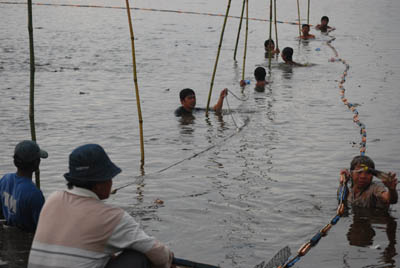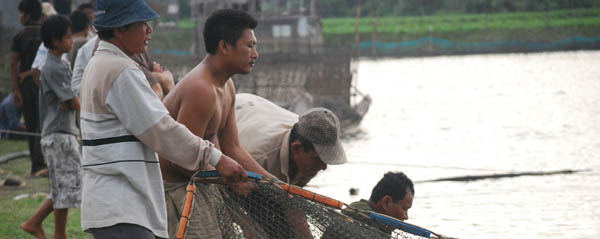Why raise native fishes if it’s easier
to
farm alien species already introduced?
Riverside restaurants in the Lao capital often hawk their barbecued fish as "Mekong fish" to unsuspecting tourists. What they're usually offering is a farmed African species introduced into the region from Japan to Thailand more than 40 years ago. This same species is increasingly seen in Cambodia and is now being stocked in Vietnamese ponds in the Mekong Delta that used to raise native catfish. Can real Mekong fishes really compete with these alien species?
Introductions of alien fish species into the countries of the Lower Mekong Basin date back to the late 17th century. According to the United Nations Food and Agricultural Organisation (FAO), the common goldfish (Carassius auratus) was introduced from China to Thailand between 1692 and 1697. Three centuries later, it was among at least 12 alien species established in the wild in Thailand. Although its date of introduction is not known, the same goldfish species has also been introduced from China to Viet Nam where it is now among at least 10 alien species established in the wild. In 2003, a study by British biologist Robin Welcomme and his Thai colleague Chavalit Vidthayonom identified 17 alien species that had either formed established populations in the Mekong Basin or had a strong possibility of doing so (see MRC Technical Paper No 9). Among them was the common carp (Cyprinus carpio). It was introduced from China to Thailand in 1913 and from Hungary to Viet Nam between 1969 and 1975 (the common carp is believed to be not one species but two groups from Asia and Europe). The study by Welcomme and Chavalit noted "considerable movement" of the common carp from Thailand and China to Lao fish farms and reservoirs. Of the major alien species introduced into the basin, they also found that at least three have been introduced into all four countries.
| Nile tilapia | |
| Khmer | Trey lapia chhnoht |
| Lao |
Pa nil |
| Thai | Pla nil |
| Viet | Ca ro phi van |
| African catfish | |
| Khmer | Trey andaing afrik |
| Lao |
Pa dug russia |
| Thai | Pla dug russia |
| Viet | Ca tre phi |
| Red-throat tilapia | |
| Khmer | Trey lapia khmao |
| Lao |
Pa nindeng |
| Thai | Pla mor thes |
| Viet | Ca ro phi thuong |
Out of Africa
The African catfish (Clarias gariepinus) was originally
introduced from the Central African Republic to Viet Nam for
aquaculture in 1974. It then spread internally throughout the
countries of the basin, initially from Viet Nam to Cambodia
and Lao PDR in the early 1980s and then from Lao PDR to Thailand
towards the end of the decade. Male African catfish have since
formed hybrids with females from an indigenous species from
the same genus, the big head walking catfish (Clarias macrocephalus).
While the alien species is not as commercially popular as the
various native species of walking catfish, Welcomme and Chavalit
found that the hybrid was "preferred" by farmers for
its better growth rates and eating quality. The Nile tilapia
(Oreochromis niloticus), also native to Africa, arrived
in the region in 1965 when it was introduced from Japan to Thailand.
Between the early 1970s and early 1990s, it was then introduced
from Taiwan, the Philippines and Thailand to Viet Nam. Itís
not clear when the species was introduced into Lao PDR and Cambodia.
The red throat tilapia (Oreochromis mossambicus), also
known as Mozambique tilapia, arrived in the region much earlier.
It was first introduced from Malaysia to Thailand in 1949. It
was then introduced from Africa and the Philipines to Viet Nam
between 1951 and 1955, the same year it was introduced from
Thailand to Lao PDR. The year of its introduction into Cambodia
is not clear. According to Welcomme and Chavalit, the red-throat
tilapia is not as highly-appreciated for its eating qualities
as the Nile tilapia. Moreover, its former popularity has "waned"
in favour of the more recently-now widely disseminated as fry
from hatcheries and is "part of established commercial
practice in support of stocking and aquaculture." The authors
of the study also noted that the Thai government hatchery at
Khon Kaen was rearing and distributing the GIFT strain of tilapia
developed by the WorldFish Center and that several private hatcheries
were licensed to produce and sell the fish for both cage and
pond culture.
Table 1: Ten farmed alien species introduced into the Mekong Basin
| Species | Route of introduction | Year |
| Mrigal carp (Cirrhinus cirrhosus) | India  Lao PDR
Lao PDR |
1977 |
India  Thailand Thailand |
1979 | |
Lao PDR  Viet
Nam Viet
Nam |
1984 | |
| African catfish (Clarias gariepinus) | Central African Repubic  Viet Nam
Viet Nam |
1974 |
Viet Nam  Lao PDR
Lao PDR |
1980 | |
Viet Nam  Cambodia
Cambodia |
1982 | |
Lao PDR  Thailand
Thailand |
1987 | |
| Grass carp (Ctenopharyngodon idella) | China, Hong Kong  Thailand Thailand |
1932 |
China  Viet
Nam Viet
Nam |
1958 | |
| Common carp (Cyprinus carpio) | China, Japan, Israel, Germany  Thailand
Thailand |
1913 + |
Hungary  Viet Nam
Viet Nam |
1969-75 | |
Thailand, India  Lao PDR
Lao PDR |
1977 | |
| Catla (Gilbelion catla) | India  Lao
PDR Lao
PDR |
1977 |
India  Thailand Thailand |
1979 | |
Lao PDR  Viet
Nam Viet
Nam |
1984 | |
| Silver carp (Hypophthalmicthys molitrix) | China  Thailand Thailand |
1913 |
China  Viet
Nam Viet
Nam |
1958 | |
| Bighead carp (Hypophthalmicthys nobilis) | China  Thailand Thailand |
1932 |
China  Viet
Nam Viet
Nam |
1958 | |
| Rohu (Labeo rohita) | India  Thailand Thailand |
1968 |
Thailand, India  Lao PDR
Lao PDR |
1977 | |
Lao PDR  Viet Nam
Viet Nam |
1982-84 | |
| Nile tilapia (Oreochromis niloticus) | Japan  Thailand Thailand |
1965 |
Taiwan, Philippines, Thailand  Vietnam
Vietnam |
1973-74 | |
?  Cambodia Cambodia |
? | |
?  Lao PDR Lao PDR |
? | |
| Pacu (Colossoma macropomum) * | ?  Thailand Thailand |
? |
*Pacu is native to the Amazon and Orinoco Basins in South America. In 2003, it was listed as introduced into adjacent waters (the Chao Praya Basin in Thailand). It has since been found in the Mekong Basin. According to Fishbase, the species was introduced into Thailand from Hong Kong and Singapore. It is considered a threat to humans as it has strong teeth that can chew hard nuts.
Source: MRC
| Dr Cacot's scorecard Potential for Sutchi river catfish | ||
| Reproduction | 5/5 | |
| Growth |
4/5 | |
| Hardiness | 4/5 | |
| Feeding | 3/5 | |
| Market value | 2/5 | |
Strong demand for indigenous species
With their characteristics not well known and with limited supplies
of fingerlings, how can indigenous Mekong fishes compete with
such alien species whose characteristics are well known and
which have better supplies of fingerlings for local farmers?
According to Cambodian fish farmer Sieng Phan, one the most
compelling reasons for raising indigenous species is that they
tend to command higher prices as local people usually prefer
them to alien species (see page 25). Lem Hai, another Cambodian
fish farmer who also runs a family catering business near Phnom
Penh, agreed. Even though he and two of his brothers farm one
of the cheapest indigenous species-the Sutchi river catfish
(Pangasianodon hypophthalmus)- he says prices compare
favourably with tilapia, for example. "Tilapia can be more
expensive but we get higher stocking densities with catfish,"
he said. "Also some people don't like tilapia which is
usually just barbecued. Catfish is better for many Cambodian and
Vietnamese dishes."But this is not just a matter of Cambodian
or Vietnamese taste. Philippe Cacot of France's Agricultural
Research Centre for International Development (CIRAD) surveyed
Lao prices for 14 indigenous fishes and five alien species at
Savannakhet market in 2005. He found that the average price
of indigenous species was about $2.40/ kg-double the price of
the alien species which averaged $1.20/ kg. Twelve of the indigenous
fishes (various species of catfishes, carps and featherbacks
as well as an eel and a snakehead) all fetched higher prices
than the three most expensive alien species (common carp, tilapia
and African catfish). And while the indigenous Sutchi river
carp and small cyprinids were cheaper than these three alien
species, they still fetched more than the other two alien species
(silver carp from China and Mrigal carp from India) which were
even cheaper.
| Krempf's catfish | |
| Khmer | Trey pra bong lao |
| Lao |
Pa suay sor |
| Thai | Pla suay sor |
| Viet | Ca bong lau |
| Jullien's carp | |
| Khmer | Trey trawsok |
| Lao |
Pa ern ta deng |
| Thai | Pla yee sok thong |
| Viet | Ca tra soc truong |
Expanding native fingerling production
Dr Cacot has been working with the Living Aquatic Resources
Research Center (LARReC) in Vientiane to address one of the
biggest constraints of the indigenous aquaculture sector-the
limited supply of fingerlings. His approach involves collecting
breeders from the wild and either stocking them in ponds to
develop new broodstock or transferring them to hatcheries to
reproduce. After spawning, the breeders in the hatcheries are
released back into the willd and the eggs produced are nursed
in tanks or ponds. After 6 to 8 weeks, some of the fingerlings
are released back into the wild while others are transferred
to grow-out ponds or cages to be sold on the market. Speaking
at the annual meeting of the MRC Fisheries Programme in Siem
Reap in June, Dr Carcot asserted that the benefits of the approach
were twofold. By diversifying production and improving hatchery
and nursery techniques, it was contributing to aquaculture development
in the basin. And by reducing the use of alien species and possibly
protecting the wild breeders, the approach was also contributing
to biodiversity conservation.

At the Lem Brothers pond near Phnom Penh,
catfish farmer Lem Hon
(holding rope) works with Cambodian and Vietnamese labourers
to set
an encircling seine net (uon hum) as they prepare to harvest
fish for a
provincial wholesaler in May. The price of such nets can range
from as little
as 200,000 riel ($50) to as much as almost 40 million riel ($10,000).
The nets are considered medium-sized fish gear and usually last
about
three years.
Photo: Lem Chamnap
In Viet Nam, Sutchi river catfish is already a $1 billion export industry. But what about other Mekong species, apart from the nine already being promoted by the MRC Fisheries Programme? Dr Cacot identified krempf's catfish (Pangasius krempfi) as having "strong potential" for aquaculture in brackish water in the Mekong Delta, noting that the key location for this highly-migratory fruit-eating species was the Khone Falls area in southern Lao PDR. He estimated that about 55,000 breeders were caught every year around the falls as floodwaters rise in June and July. Another native fish with good potential for aquaculture, he says, is Jullien's carp (Probarbus jullieni), an endangered species that grows to 150 cm.
Table 2: Species farmed in the region
| Native species | No |
Alien species | No |
Hybrids | No |
| Carps | 8 |
Chinese carps | 3 |
Shark catfishes | 3 |
| Shark catfishes | 7 |
Indian carps | 3 |
Walking catfishes | 1 |
| Other catfishes | 6 |
Common carp | 1 |
||
| Climbing perches | 5 |
Tilapia | 1 |
||
| Featherbacks | 2 |
African catfish | 1 |
||
| Eels | 2 |
Eels | 1 |
||
| Other prey fishes | 2 |
||||
Total |
32 |
10 |
4 |
||
| Annual production * | 545,000 |
191,000 |
114,000 |
*FAO estimates in tonnes (2005). Production estimates for alien species and hybrids are believed to be conservative. Estimates for native species do not reflect the surge in annual Mekong Delta production of the Sutchi river catfish (Pangasianodon hypophthalmus) which recently exceeded 1 million tonnes. Production of the other dominant native species in regional aquaculture, the Java barb (Barbonymus gonionotus), is estimated at 100,000 tonnes a yaer.
Source: Philip Cacot, Agricultural Research Centre for International Development (CIRAD)

Dr Cacot addressing the annual
meeting of the MRC Fisheries
Programme in Siem Reap in June
Photo: Lem Chamnap
Faster growth but higher mortality
More than 300 individuals of this species are caught every year
in December and January at a fishing ground next to Kho island,
about 14 km upstream from Pakse in southern Lao PDR. Using a
temporary hatchery on the island, the French biologist said
that initial trials showed that "stripping" the spawning
breeders for artificial propagation produced about 210,000 eggs
of which about 150,000 actually hatched, resulting in 70,000
fingerlings after 6-8 weeks. The initial trial found that Jullien's
carp grew much faster than the common carp during the first
eight weeks after hatching. Growth rates were similar in the
first few weeks, although the indigenous species was slightly
larger at about 23mm after 25 days compared with about 20mm
for the alien species. But the growth rates then started to
diverge dramatically and after 60 days, the Jullienís carp fingerlings
were about 50mm compared with only 30mm for the common carp
fingerlings. On the other hand, the alien species had a higher
survival rate of 39% which compared with only 16% for the indigenous
species. Could production of these fingerlings be an alternative
or complementary form of income for fishermen around Kho island?
Dr Cacot reckons fingerling production for this species could
be even more profitable than the fish catch now if fishing restrictions
are put into place. The local Jullienís carp fishery currently
involves about 55 boats from three villages. Assuming an annual
catch of 400 fish weighing a total of 4.4 tonnes and a wholesale
price of $3.50/kg, he estimates annual net income of about $12,400
from the existing fishery. At the same time, however, an estimated
42 million eggs are lost every year.
A model for the region
If fishing restrictions reduce the catch by 75% to only 100
fish a year weighing 1.1 tonnes, he forecasts that wholesale
prices will double to about $7/kg. But that still won't be enough
to compensate fishermen whose combined net incomes would then
be $6,200, only half as much as they were before. The solution?
A modest investment of $10,500 to build fifty 30m≤ canvas ponds.
By stocking the ponds at a density of 250 fingerlings per square
metre, Dr Cacot estimates that the additional eggs no longer
lost as food could produce 375,000 fingerlings a year. If these
fingerlings are sold to farmers at a rate of five cents each,
estimated revenues would be $17,600 a year, generating net income
of $7,100 once the investment costs are taken into account.
Combined with the net income from the restricted fishing catch,
total net income would be $13,300 a year, which is 7.3% more
than what the fishery is earning now. Dr Cacot believes this
model is sustainable for the whole region. So what next? "The
use of the wild fish breeders seems to be a promising means
of developing aquaculture while preserving the wild broodstock,"
Dr Cacot told the annual meeting in June. Moreoever, "there
is an urgent need to protect fish reproduction." Mature
breeders make up about 40% of the total catch in Champassak
province in Lao PDR and the Cambodian provcinces of Stung Treng
and Kratie. The combined catch is estimated at 2,000 tonnes
every year, with many of the fish-and millions of eggs-ending
up in fancy restaurants in Thailand. "Further research
is necessary to fully control reproduction and nursing of the
fish, checking the feasibility of production in various conditions,
assessing the market for fingerlings, and assessing the effective
potential for grow-out," Dr Cacot said "At the same
time, regional exchanges are needed among the four MRC countries
in areas such as information, study tours and training. The
four countries could also exchange fishes in accordance with
genetic considerations."But other steps are also needed
by policymakers to promote indigenous species for commercial
aquaculture. According to Dr Cacot, "public agencies should
assist the private sector in providing fingerlings, broodstock
and technical support." He also called for controlling
the "footprint" of alien species by banning hybrids
as well as the practice of using methyltestosterone to induce
sex reversals in tilapia. Methyltestosterone is an anabolic
steroid used to treat men with testerone deficiency and women
with breast cancer as well as breast pain and swelling following
pregnancy. It is also combined with estrogen to treat symptoms
associated with menopause.

Vietnamese employees of a Cambodian fish
wholesaler get ready to harvest several tonnes of catfish at
the Lem Brothers fish farm on the outskirts of Phnom Penh in
May. After setting the encircling seine net (uon hom) in the
late afternoon, the fish were harvested shortly after midnight
and transferred live by truck to markets in Kampong Cham, about
three hours away by road.
Photo: Lem Chamnap
Further reading
Welcomme, R and Chavalit Vidthayanom (2003), The impacts
of introductions and stocking of exotic species in the Mekong
Basin and policies for their control, MRC Technical Paper
No 10, Mekong River Commission, 38 pp
Choose a newsletter: